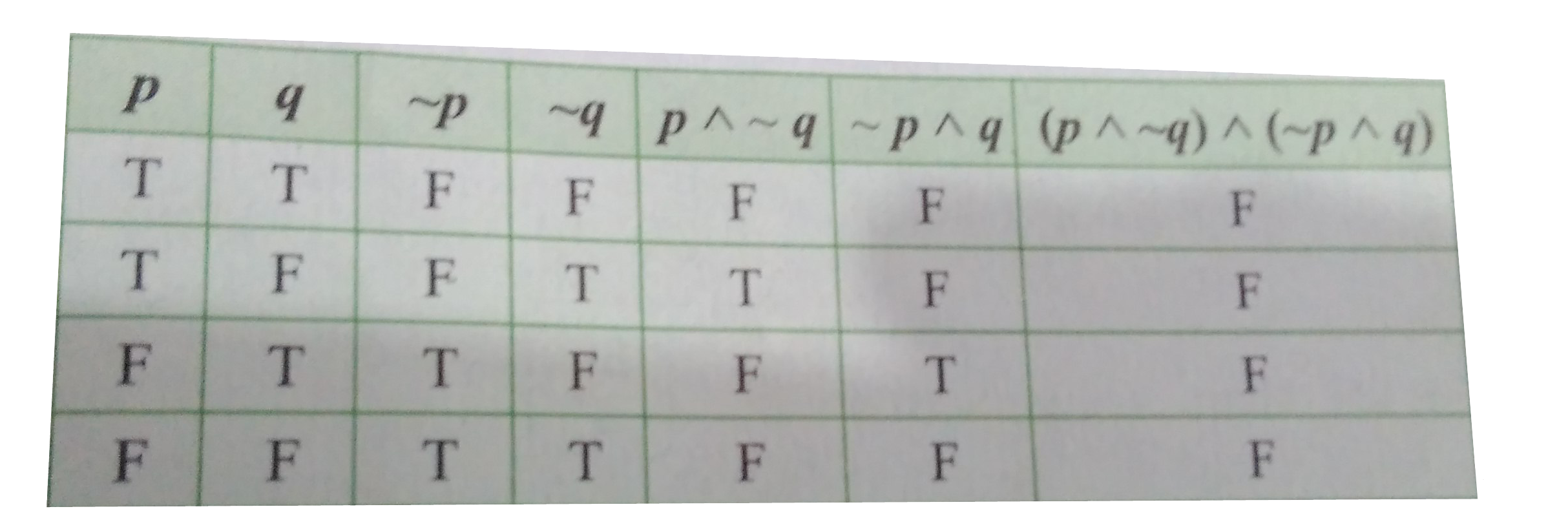Consider :
Statement I:
is a fallacy
Statement II: is a tautology Solution in Tamil
Statement-1 is true, statement 2 is true, statement 2 is a correct explanation for statement 1
Statement 1 is true, statement-2 is true, statement 2 is not a correct explanation for statement 1
Statement 1 is true , statement 2 is false,
statement 1 is false, statement 2 is true
The correct Answer is:B

It is fallacy

Topper's Solved these Questions
- MATHMETICAL REASONINGBook:CENGAGEChapter:MATHMETICAL REASONINGExercise:Exercise (Single)
Explore 38 Videos
- LOGARITHM AND ITS PROPERTIESBook:CENGAGEChapter:LOGARITHM AND ITS PROPERTIESExercise:JEE Previous Year
Explore 5 Videos
- MATRICESBook:CENGAGEChapter:MATRICESExercise:Multiple Correct Answer
Explore 7 Videos
Similar Questions
Which of the following is not a statement.
View SolutionShow that the equation esinx−e−sinx−4=0 has no real solution.
View SolutionIf A=⎡⎢⎣100101010⎤⎥⎦, then
View SolutionStatements -1 : ~(pharr~q) is equivalent to p harr q Statement-2: (~ p harr ~q) is a tautology.
View SolutionConsider :
Statement I:
(p∧~q)∧(~p∧q) is a fallacy
Statement II: (p→q)↔(~q→~p) is a tautology
View SolutionStatement-1 : (p∧~q)∧(~p∧q) is a fallacy.
Statement -2: (p→q)↔(~q→~p) is a tautology .
View Solutionconsider :
Statement - I : (p∧~q)∧(~p∧q) is a fallacy .
Statement -II : (p→q)↔(~q→~p) is a tautology .
View SolutionStatement - I : (p∧~q)∧(~p∧q) is a fallacy.
Statement - II : (p→q)↔(~q→~p) is a tautology.
View SolutionConsider two statements
S1:~p→(~q⇒~p) is a tautology
S2:(~q∧p)→q is a fallacy then
View SolutionConsider :
Statement-1 : (p∧~q)∧(~p∧q) is a fallacy.
Statement-2 : (πmpliesq)⇔(~q⇒~p) is a tautology.
View SolutionStatement -1 : ~(P harr ~q) is equivalent to p harr q Statement - 2 : ~(P harr ~q) is a tautology.
View SolutionLet p and q be any two propositons
Statement 1 : (p→q)↔q∨~p is a tautology
Statement 2 : ~(~p∧q)∧(p∨q)↔p is fallacy
View Solutionकथन - 1 : ~ (p ↔ ~ q) और p ↔ q तुल्यमान (equivalent) हैं।
कथन -2: ~ (p↔ ~q) एक पुनरुक्ति (tautology) है ।
View SolutionConsider :
Statement I:
(p∧~q)∧(~p∧q) is a fallacy
Statement II: (p→q)↔(~q→~p) is a tautology
View SolutionStatements -1 : ~(pharr~q) is equivalent to p harr q Statement-2: (~ p harr ~q) is a tautology.
View Solution

